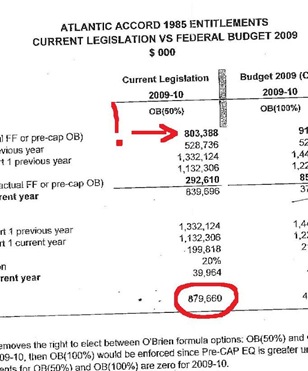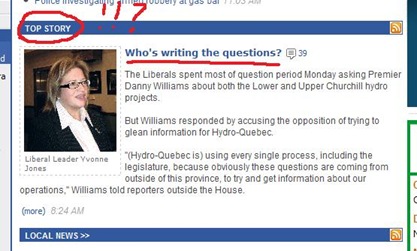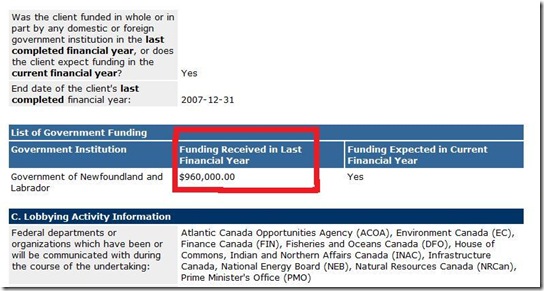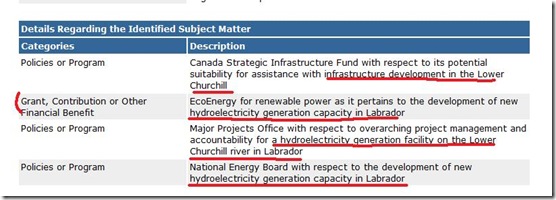In his most recent column, Telegram editorial page editor Russell Wangersky highlights a concern of his, namely the practice in the prime minister’s office of pumping out huge volumes of still and moving images of the prime minister and pushing them into newsrooms across the country.
But the concept of having political staffers take over or contract out control of the reins of one part of the media has some interesting repercussions.
Which part? Editorial control over images of the prime minister.
Wangersky’s column highlights different aspects of the issue beyond just pushing out large quantities of content. There is the control over access to events such that only the PMO staffers will be there, not reporters and shooters for the news media.
Then there’s the problem of what Wangersky terms falsification:
One picture of Harper on stage at the National Arts Centre was released earlier this year as a still of him performing in front of a live audience. It was later revealed that the photo was staged and shot during a rehearsal, but the only reason that came out is that press photographers figured out the angle the photograph was taken from, and knew that no photographer had been in the centre of the stage during Harper's performance.
Wow.
Now this is not the first time someone on the editorial side of the news world has raised issues about this sort of thing. A couple of years ago, controversy erupted in the United States over video news releases produced by or on behalf of the Bush White House. The VNRs, as they are called, were short video versions of a news release done in the style of a television news cast. They were all clearly labelled when they were sent out as to where they came from.
The controversy surrounding VNRs is much wider than just the Bush example, though. VNRs were turning up in news casts as if they had been produced by a news organization like Associated Press, Canadian Press, Reuters or any of a host of others. Viewers didn’t know the difference since the source of the video was never identified.
Now from perspective of someone in the public relations business – where your humble e-scribbler toils – Wangersky’s comments come across as a bit curious.
You see, sending out photos, videos and even news releases is basically just a way of getting information into the hands of reporters and editors. That’s all it does. They get to read or view the material and then decide what – if anything – they want to do with it. In and of itself, the act of sending out this material doesn’t do anything to control any media reins.
There is nothing either new or novel in hiring photographers to shoot your event. it’s been happening for years in civilian settings.
In some instances, such as military or coast guard situations, having a civilian shooter just isn’t always practical.
Face it, if you’re the public affairs officer at 103 in Gander, you just aren’t going to roust the Telly photo editor out of bed at three in the morning to go along for a ride to some mission off the coast. His family and neighbours might not like the helicopter stopping off in his backyard anyway.
But aside from that and the fairly obvious liability issues, there is only so much space on the aircraft. Any civilian shooter becomes just so much excess baggage at that point. in a tough spot, he or she is just damn well in the way. At least if the PAO sends along the military photo tech, that person has some skills and abilities to offer to support the mission directly if the need arises. In the meantime, the photo tech stands a better chance of getting a dramatic, high-quality shot that otherwise would never be seen .
Now some of you are already squirming that what Russell talked about in his column is different. In some respects it is.
But in others it isn’t. There’s fundamentally nothing different from what Russell described and hat happened 20 years ago and more in this province, back when all the newspapers weren’t owned by the same company. All that has changed is the technical way photos and other content get to the editors away from the major centre.
The choice on what to do with the material remains with the editor.
Incidentally, that’s what the VNR problem really was: some editors in some markets were passing off the VNR as if it was something put together at the local station or by some other news organization.
The situation Russell described becomes a problem in two situations. One is where the editors don’t label the content to tell their audience where it came from. The second is where an organization like the PMO is restricting news media access solely to force them to use PMO content.
Not so very long ago, neither one of those things was very likely. If the PMO tried to push that kind of control, there’d be howling from every editorial space in the nation. Blackball a reporter and you’d quickly find crappy stories running about your guy on the front page of every section, including sports and the comics.
As for the cut and paste job, there might be some of it but for the most part there were enough scribblers and shooters to generate the content for the daily paper or the evening news. On the PR side of the street you could try and see how much of your copy got through the editors but the best anyone could usually do was about 60 to 70 percent on a straight-up story. Well-written copy in a news format would just sail through. On anything controversial you would watch that number slide downwards toward zero pretty fast.
Not so much any more, though. These days newsrooms are strapped for cash and bodies and they need to generate more content for more platforms. Even the absolutely worst government news releases full of turgid government-speak will find their way readily into a story in print or radio. The most simple of claims – I have letters of support from all the Premiers – is unlikely to stimulate the question “Can we have copies, please?”
If it does happen but nothing shows up there really isn’t much anyone can or will do about it. News outlets need content and in today’s environment a large, well funded bureaucracy that spits out content at a high rate of speed will easily swamp everyone and everything. No editor has the time or money to get people look at other angles and if the reporter gets cut off, their access to content disappears.
No content means no broadcast or paper, that is no vehicle. No vehicle means no advertising and no advertising, no money for salaries. It’s a vicious circle. Audiences are dropping anyway, so any further loss of revenue has huge implications.
Even budget allocations at the Mother Corp are driven to some extent by ratings. If your show has no listeners or viewers, rare is the one that can survive come budget time. No one in the conventional media is immune from either the cause or the effect.
The power balance between reporter and the ones reported on has shifted decidedly in favour of the latter. What made Paul Oram’s moaning about CBC so laughable is that whatever they did to him was but a pale shadow, a caricature of the roasting then social services minister Charlie Brett got in the late 1980s after suggesting that juvenile delinquency could be reduced if women stayed home and looked after the children. Imagine if he’d suggested paying cash bonuses for live births.
The power balance has shifted alright and it is not a healthy trend. Refusing to use the content – as Russell suggests – won’t stop the flow. These days, the PMO can count on competition for scarce dollars to make every confrontation with reporters an object lesson in The Prisoner’s Dilemma.
And if nothing else, the Internet allows any organization to reach a very specific audience without having to work through the filters of reporter and editor. How long will it be before an organization can target its external comms straight at its audiences and hit exactly who they want to hit with what they want when they want?
When newspapers, radio and television were the only game in town, people on both sides had to play nice. These days, a government comms director who gets word the Telly is refusing to take government content will have a great laugh and then line up another call to Open Line for The Boss.
If Randy doesn’t fit the need, there’s always another reporter a blackberry PIN or e-mail away who will gladly take what you’ve got in the shop window that day. Offer it up as a “such and such a news organization has learned…” and you can be guaranteed the hook will be well seated not just in the flesh but in the jawbone itself.
Times have changed.
The space at the Telly, for example, used to be valuable, even for Joe Smallwood in the hardest hitting days of Ray Guy. Even a decade ago, Brian Tobin could feed stories to a reporter at the Telegram knowing that by getting its front page – as he usually would – Tobin could also pick up the two television newscasts right behind.
These days when a paper can manage to squeeze a week’s worth of copy - and a couple of front pages - out of the Premier’s rehashed and recycled comments from an editorial board, the perceived value of that print space has dropped like the price for those old Milli Vanilli tapes tucked away in the attic.
That’s not the way it should be, but that may also be irrelevant.
-srbp-







![churchillfallssigning1969[4] churchillfallssigning1969[4]](http://lh3.ggpht.com/_1JCeohwjuLE/SxR_KQoZB4I/AAAAAAAACMo/cKWlGPOAjV8/churchillfallssigning1969%5B4%5D%5B6%5D.jpg?imgmax=800)